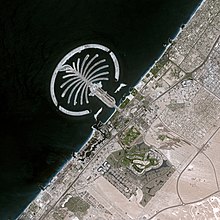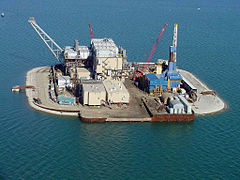Artificial island
An artificial island or group of islands is an island or group of islands in a sea or an inland body of water that has been artificially created in whole or in part . The size varies from small embankments that can accommodate a column of a building, for example, to islands on which entire cities are built.
Purpose and origin
Early man-made islands were wooden or stone structures erected in shallow waters. Today's artificial islands are usually created through land reclamation . These are often military or commercial extensions of existing islands (on which an airport is built, for example ) or, more recently, tourist structures such as the Palm Jumeirah in Dubai . Artificial islands are also being built to gain settlement space, especially in metropolitan areas, such as the Venetian Islands near Miami from the 1920s or numerous artificial islands in Tokyo Bay . Artificial islands can also be used for political and economic control, such as Dejima Island in Nagasaki Bay , which was used for all trade and external contact between Japan and Europe in the Edo period . Some artificial islands have also been created for nature conservation projects, such as the island of Nigehörn .
Artificial islands are also created, among other things, by separating a piece of land from the surrounding area by building a canal, for example, as was the case with the Danube Island . Other artificial islands are formed when dams are built , parts of which now protrude above the water surface of the reservoir ( Barro Colorado Island or the world's largest artificial island, René Levasseur Island ).
history

Although they are a symbol of modern times, the creation of artificial islands has a long history in many parts of the world. It goes back to ancient Egypt , to the Crannógs in Scotland and Ireland , the ritual center Nan Madol on the Carolines and the floating islands of the Urus in Lake Titicaca . Tenochtitlan , the capital of the Aztecs , stood on a small natural island in Lake Texcoco , which was surrounded by countless artificial islands ( chinampas ).
The locals of the Langa Langa lagoon and the Lau lagoon on Malaita ( Solomon Islands ) created 60 artificial islands on the reef to protect themselves from attacks by the inhabitants of the interior of Malaita. The artificial islands were literally built stone by stone: the families took their canoes out to the reef and dived for stones, which they dropped back into the water at the construction site. Life on the artificial islands was also healthier as mosquitoes were not a part of it.
Many artificial islands were created at ports, on the one hand to seal them off from the city, but above all to save building land in the densely populated cities. An example of the first case is Dejima in Nagasaki Bay , built in the Edo period . The island served as a closed center for Dutch traders. During the closure of Japan , the Dutch were not allowed to enter Nagasaki; conversely, the Japanese were not allowed to enter Dejima. Ellis Island was raised in Upper New York Bay for a similar reason . The island served as a self-contained collection point for immigrants to the United States in the late 19th and early 20th centuries. Another well-known artificial island is the Île Notre-Dame in Montreal , built for Expo 67 . The so-called Texas Towers , built as artificial islands, were military installations of the USA.
Largest artificial islands
| rank | Surname | Size (km²) | place | purpose |
|---|---|---|---|---|
| 1 | René Levasseur Island | 2,030 |
Quebec , Canada |
Nature reserve |
| 2 | Flevopolder | 970 | Netherlands | City foundation, agriculture |
| 3 | Yas Island | 25th |
Abu Dhabi , United Arab Emirates |
Yas Marina Circuit |
| 4th | Kansai Airport Island | 10.5 | Japan (near Osaka ) | Airport |
| 5 | Chek Lap Kok | 9.38 |
Hong Kong , China |
Airport |
| 6th | Palm Islands | 8th |
Dubai , United Arab Emirates |
in progress |
| 7th | Chūbu airport island | 6.8 | Japan (near Nagoya ) | Airport |
| 8th | Palm Jumeirah | 6.5 |
Dubai , United Arab Emirates |
housing |
| 9 | Rokkō Island | 5.8 | Japan ( Kobe ) | housing |
| 10 | Port Island | 5.2 | Japan ( Kobe ) | housing |
Modern projects
Netherlands
In 1969 the Flevopolder in the Netherlands was completed as part of the Zuiderzeewerke . With an area of 970 km², Flevopolder is the largest artificial island in the world that was created through land reclamation. The island consists of two polders , East Flevoland and South Flevoland . Together with the Noordoostpolder they form the province of Flevoland .
Qatar
The Pearl is located northeast of Doha in the Emirate of Qatar . On the island u. a. Villas, luxury hotels, restaurants and shops were built. The Qanat Quartier on the island is set to become the Venice of the Middle East.
Dubai, UAE
Several artificial island projects are currently being built in Dubai . Including the Palm Islands - Palm Jumeirah , Palm Jebel Ali and Palm Deira ; as well as The World and Jumeirah Islands . The luxury hotel Burj Al Arab is also located on an artificial island.
China
A land reclamation project is running in China called the Great Wall of Sand , in which seven reefs on the Spratly Islands in the South China Sea were artificially enlarged by mid-2015 . China built a runway, several military facilities and villages to assert territorial claims.
Airports
In 1994, the Japanese Kansai Airport was the first airport to be built entirely on an artificial island. Also in Japan, Chūbu Airport was built in 2005 and Kobe Airport in 2006 on artificial islands. For Hong Kong International Airport , which opened in 1998 , 75% of the area was created by enlarging the islands of Chek Lap Kok and Lam Chau .
gallery
Northstar Island , an artificial island that was built in the course of oil drilling in the Beaufort Sea .
Political status
According to the International Convention on the Law of the Sea , artificial islands are not considered to be port facilities (Art. 11) and are under the administration of the nearest coastal state as long as they are within the 200-mile zone (Art. 56). Artificial islands do not have the status of islands. They do not have their own territorial waters and have no influence on the extent of the 200-mile zone (Art. 60). On the other hand, any state may create artificial islands on the high seas (Art. 87).
See also
Individual evidence
- ^ The Story of Ancient Egypt . Retrieved October 8, 2016 .
- ↑ Tenochtitlán - The capital of the Aztecs. Indianer-Welt.de, accessed on October 8, 2016 .
- ^ David Stanley: South Pacific Handbook . 6th ed.Moon Travel Handbooks, ISBN 978-1-56691-040-8 , pp. 832 .
- ↑ Tomoya Akimichi: Sea Tenure and Its Transformation in the Lau of North Malaita, Solomon Island. (pdf) (No longer available online.) South Pacific Study Vol. 12, No. 1, 1991, archived from the original on May 22, 2014 ; accessed on October 8, 2016 . Info: The archive link was inserted automatically and has not yet been checked. Please check the original and archive link according to the instructions and then remove this notice.
- ^ Largest Lake Islands of the World . Archived from the original on September 28, 2011 Info: The archive link was inserted automatically and has not yet been checked. Please check the original and archive link according to the instructions and then remove this notice. . Retrieved January 1, 2007.
- ↑ a b Presenting Properties in Excess of Five Million Dirhams by LUXHABITAT | Luxury homes and properties in UAE . Luxhabitat.ae. Retrieved July 15, 2012.
- ↑ Der Spiegel : China is building artificial island in the South China Sea from November 28, 2014
- ↑ The Press : China's Resolute Reach for Reefs and Islands, July 22, 2015, accessed October 8, 2016.
- ↑ United Nations Convention on the Law of the Sea. Retrieved October 8, 2016 .




